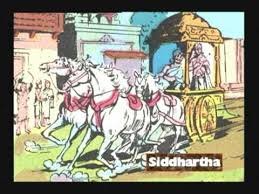Legacy of Ashoka
Emperor Ashoka

Legacy of Ashoka
The reign of Ashoka Mauryan could easily have disappeared into history as the ages passed by, and would have, if hadnt he left behind a record of his trials. The testimony of this king was discovered in the form of magnificently sculpted pillars and boulders with the actions and teachings he wished to be published etched into the stone. What Ashoka left behind was the first written language in India since the ancient city of Harrapa. Rather than Sanskrit, the language used for inscription was the current spoken form called Prakrita. In translating these monuments, historians learn the bulk of what is assumed to have been true fact of the Mauryan Empire. It is difficult to determine whether or not some actual events ever happened but the etchings clearly depict how Ashoka wanted to be thought of and remembered.
The pillars, chiseled from stone, could weigh to fifty tons a piece. These would habitually be topped off with the sculpture of a lion or bull and carry the word of the king around its base. The transportation of each rock and pillar was a major ordeal, it may take several hundreds to hoist the artifact into place or onto a vessel capable of travel with such extreme weight. Each edict was sent to the outstretches of the empire so all could read, or be read to, the royal dharma. Most commonly the more elaborate works were sent to places of national importance and spiritual recognition, such as the birth place of Gotama.
Pillar Edict II when translated describes the middle path, the way to enlightenment through dharma that the Buddha taught in his first sermon. Others such as Pillar Edict VII, quote Ashoka as remarking I consider the promotion of my peoples welfare my highest duty. Professor Tambiah, an anthropologist of the University of Chicago translates Rock Edict XI as reading, There is no gift that can equal the gift of dharma, establishment of human relations in dharma, the distribution of wealth through dharma, or the kinship in dharma. Many of the etchings are complex and contradicting but those of the day got the message loud and clear. years preaching the dharma in order to unify his people. Just as he will never be forgotten, neither will his efforts to impose his great force of dharma. This is why the people of modern India have taken his image of the wheel of dharma from the sacred pillars and forever embedded it in the center of their national flag. Its no wonder in all his achievements, Ashoka, the Buddhist King, has inspired infinite cultures, multiple religions, and One nation under god, with liberty and justice for all.
 Equality for All
Equality for All Biography
Biography Battle of Kalinga
Battle of Kalinga Ashokstambha
Ashokstambha Conversion to Buddhism
Conversion to Buddhism Policy
Policy Rise to Power
Rise to Power Accession to the Throne
Accession to the Throne Ashoka Chakra
Ashoka Chakra Embracing Spreading Buddhism
Embracing Spreading Buddhism Lion Capital of Asoka
Lion Capital of Asoka Legacy of Ashoka
Legacy of Ashoka Test your English Language
Test your English Language  Precautions while using Nail Paint
Precautions while using Nail Paint Unbelievable Facts About Alcohol
Unbelievable Facts About Alcohol Weird Restaurants
Weird Restaurants Tips to get ready for Work
Tips to get ready for Work Benefits of Pumpkins
Benefits of Pumpkins Precautions while using WhatsApp
Precautions while using WhatsApp Healthy Brow
Healthy Brow Different ways to Drap Saree
Different ways to Drap Saree Benefits of Apricots
Benefits of Apricots Most Amazing Fountains Around The World
Most Amazing Fountains Around The World Most Amazing Roads
Most Amazing Roads Most Amazing Streets in the World
Most Amazing Streets in the World




